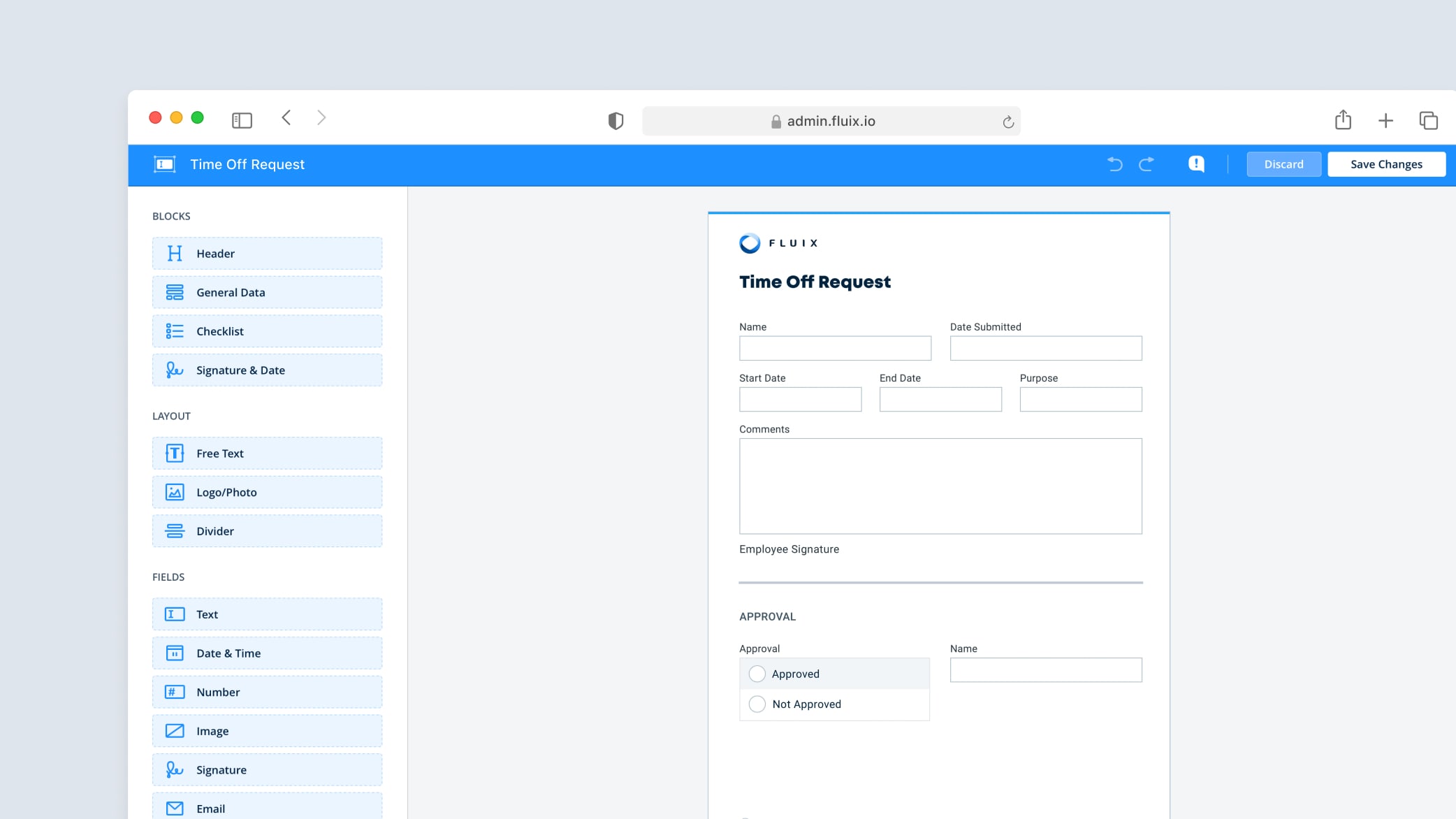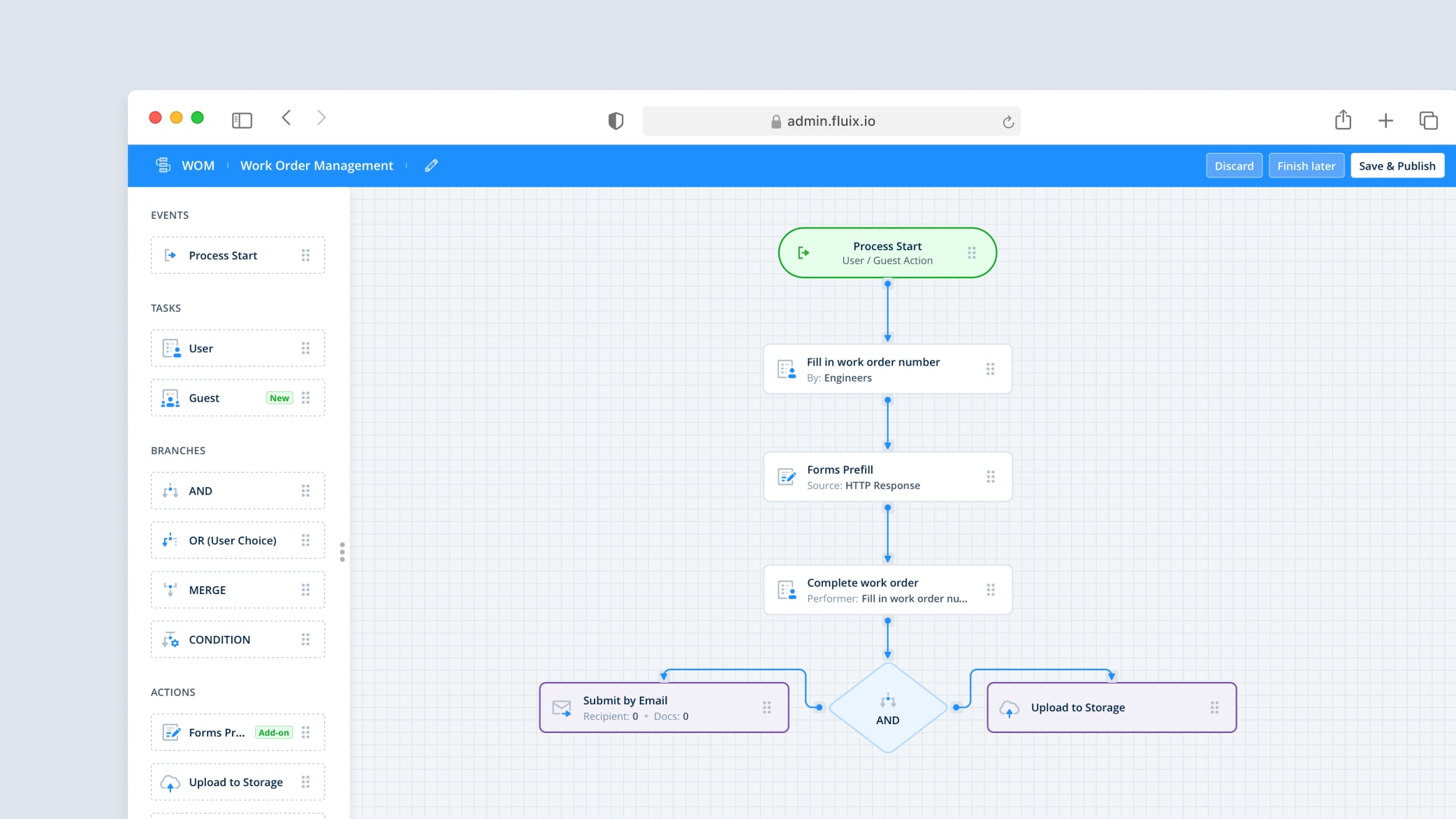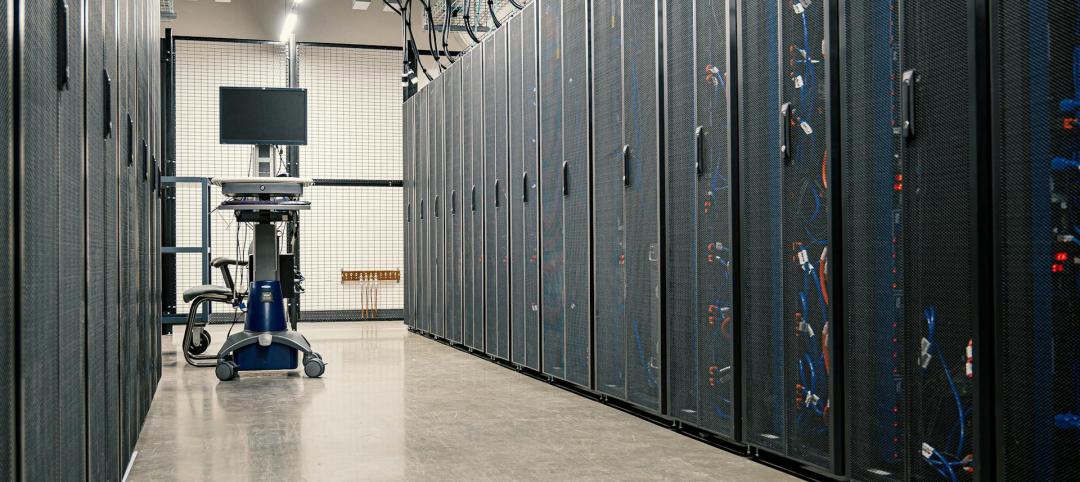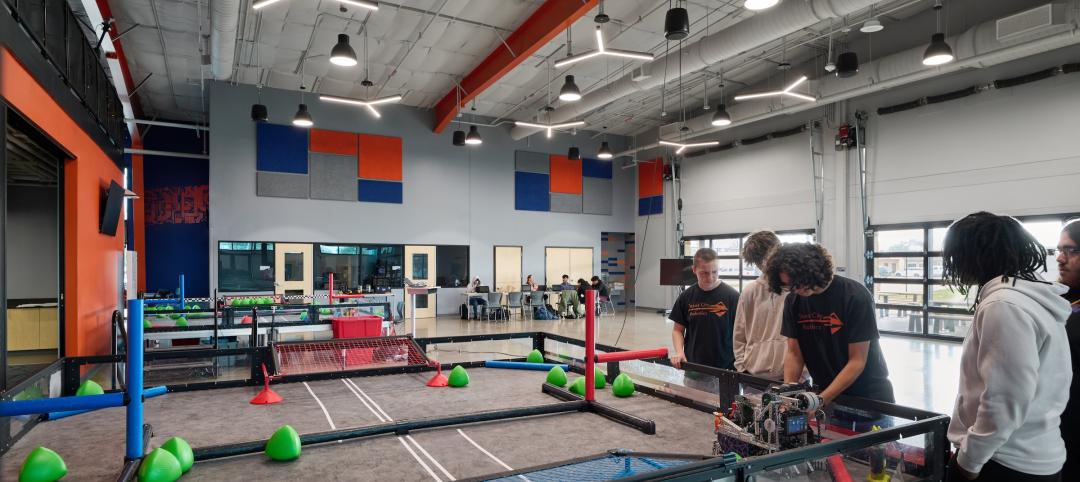This is the second article in a three-part series on digital transformation. Click here to read part one: What's driving the surge of digital transformation in AEC today?
In today's ever-evolving landscape, digital transformation has become a major force, reshaping the way many industries operate. And the AEC sector is no exception. While going digital might seem like a playground solely for industry giants, the truth is that any company can benefit from the power of technology.
The key is to identify critical processes as a primary focus, set clear objectives, choose optimal tools, and expand only after achieving success in these areas.
Common Use Cases of Digital Transformation in AEC
In this article, we’ll take a look at common use cases of digitalization in the field and highlight the benefits it brings. Through real-world success stories of Fluix’s customers, we’ll provide practical insights into how digital solutions can streamline operations, boost efficiency, and ensure a more competitive and sustainable future.
And in case it’s your first time hearing about Fluix, it’s workflow automation software that for nine years has been helping construction businesses improve their document-based processes management, from form creation to approval and storage.
1. Paper Document Digitization
An average mid-sized construction project involves managing hundreds to thousands of individual documents, including plans, contracts, permits, invoices, safety records, and more. Handling these documents manually results in inefficiencies, document loss, version control problems, and high printing and storage costs.
These problems can be mitigated, if not completely averted, by the simple act of converting paper documents into digital formats. With the available tools, it won’t be hard—yet the impact on your productivity would be crucial.
Take the example of LUDWIG FREYTAG, a German construction leader, who digitized various documents to improve timesheet accuracy and reduce administrative work.
Furthermore, the introduction of barcodes in equipment shipment documents significantly reduced the need for manual data input and expedited the delivery of these documents to the office. They saved time with mobile form filling as well. Field technicians could fill out and sign forms on iPad, with no need to carry heavy paper binders from the site to the office.
Similarly, Leach Wallace Associates streamlined field processes with digital checklists and achieved improved safety compliance and efficiency.
In both cases, the mere replacement of paper within critical processes improved efficiency and reduced operational costs.
Any business can copy these techniques. What you need for a start is a good document management tool that allows you to create, store, organize, and retrieve digital documents. Choose between options like Microsoft SharePoint, Google Drive, Dropbox, or dedicated construction document management software like Procore, Fluix, or Autodesk Docs.

2. Electronic Signatures
Signing documents is an integral part of construction projects, involving various documents at different stages: contracts at pre-construction, change orders during planning, safety documents, payments, warranties, manuals, etc. And manual signing is typically a long process.
Imagine you need to sign, say, an equipment rental agreement. With traditional signing, you print the document, physically distribute it to the involved parties (often time-consuming), wait for them to sign and send the file back. And then you need to review the signed agreement to ensure all signatures are in place and the terms are correct. Which can introduce more delays.
And this is the same process done electronically. You deliver the document through the e-signature tool. Everyone receives an email or notification with an access link. They review and sign it from their preferred devices, without the need for physical meetings. You track the progress, knowing when it’s signed by everyone. Speed, efficiency, and accuracy are higher; costs are lower.
Colorado Living, a family-owned home improvement company, benefited from e-signature, achieving a 1.5-hour daily time-saving per salesperson, and their contracts reached the office within minutes instead of 24 hours.
Comfort Systems USA, a commercial HVAC contractor, and Reborn Cabinets, a US remodeling company, both reported improved customer experience with e-signatures, cutting down contract turnaround time and cost savings through reduced paper usage.
In addition to these benefits, e-signature allows for legal validity, efficient archival processes, and even, to some extent, reduced environmental impact.
The thing to consider when choosing a tool is legal compliance and security. Ensure it complies with relevant legal regulations, such as the Electronic Signatures in Global and National Commerce (ESIGN) Act and the Uniform Electronic Transactions Act (UETA) in the United States. Compliance with other e-signature standards, like the European Union's eIDAS Regulation, is essential if you operate in the region.
3. Workflow Automation
Complete workflow automation is the ultimate goal of effective project management. It’s not always technically possible, as you may work with contractors, clients, agencies who will need a direct approach. But the automation of key processes alone, say inspections, quality control, and approvals, will have a great impact on your operational performance.
When Centuri Group, Inc., a utility infrastructure services enterprise, faced some project delays and communication gaps, they invested in workflow automation. It paid off fast, improving communication and control over field processes. An impressive 50% to 75% reduction in annual reporting time, and generation of actionable insights from data analytics were also achieved.
Their success relies on several main foundations. First, they started with a well-defined strategy and roadmap for implementation. Their leadership supported digital change and prioritized efforts to ensure that employees adapted to new technologies.
Second, they carefully chose the technology partner. The customer success and product teams of Fluix, which was used as the main tool, provided the necessary support and scalability, helping with the initial settings and team onboarding.

4. Data Collection with Mobile Apps and Tablets
Data collection in AEC supports various functions like site assessments, quality control, safety monitoring, predictive analytics, collaboration, and communication among stakeholders.
And when you collect your data using mobile apps, things go faster and more accurately. In addition to simply being a more convenient tool, apps enhance efficiency by allowing real-time data entry and validation, secure data storage, instant accessibility, and integration with databases for quick data sharing and analysis.
With safety always being a top priority in the AEC industry, mobile apps enable real-time safety inspections, reporting, and incident documentation. This proactive approach to compliance helps identify and mitigate risks promptly, ensuring the well-being of workers on the site.
That was the main reason why Dyna Crane, a Canadian crane service provider, switched to automated workflows and mobile data collection. The switch resulted in 3,185 labor hours and $286,650 saved annually; safety documents digitally backed-up and available on-demand for inspection; digital service records used for efficient predictive maintenance.
One more good thing about the value of mobile apps is that it increases significantly as the volume of your data grows, resulting in greater statistical significance, and improved risk mitigation.
Last Word
Digital transformation is not just a buzzword; it's a reality that is reshaping the AEC industry, and you must embrace the changes to stay competitive. It’s no rocket science to assume that companies who adopt digital tools and processes will complete projects faster, with less risks, and more efficiently, will offer better value, and attract clients, possibly away from your business.
If you haven't researched or planned your digital transformation so far, it’s high time you started (if you want to position your organization for success in the upcoming years).
Related Stories
Adaptive Reuse | Aug 14, 2024
KPF unveils design for repositioning of Norman Foster’s 8 Canada Square tower in London
8 Canada Square, a Norman Foster-designed office building that’s currently the global headquarters of HSBC Holdings, will have large sections of its façade removed to create landscaped terraces. The project, designed by KPF, will be the world’s largest transformation of an office tower into a sustainable mixed-use building.
Sustainability | Aug 14, 2024
World’s first TRUE Zero Waste for Construction-certified public project delivered in Calif.
The Contra Costa County Administration Building in Martinez, Calif., is the world’s first public project to achieve the zero-waste-focused TRUE Gold certification for construction. The TRUE Certification for Construction program, administered by Green Business Certification Inc. (GBCI), recognizes projects that achieve exceptional levels of waste reduction, reuse, and recycling.
Modular Building | Aug 13, 2024
Strategies for attainable housing design with modular construction
Urban, market-rate housing that lower-income workers can actually afford is one of our country’s biggest needs. For multifamily designers, this challenge presents several opportunities for creating housing that workers can afford on their salaries.
Energy Efficiency | Aug 9, 2024
Artificial intelligence could help reduce energy consumption by as much as 40% by 2050
Artificial intelligence could help U.S. buildings to significantly reduce energy consumption and carbon emissions, according to a paper by researchers at the Lawrence Berkeley National Laboratory.
Sponsored | Healthcare Facilities | Aug 8, 2024
U.S. healthcare building sector trends and innovations for 2024-2025
As new medicines, treatment regimens, and clinical protocols radically alter the medical world, facilities and building environments in which they take form are similarly evolving rapidly. Innovations and trends related to products, materials, assemblies, and building systems for the U.S. healthcare building sector have opened new avenues for better care delivery. Discussions with leading healthcare architecture, engineering, and construction (AEC) firms and owners-operators offer insights into some of the most promising directions. This course is worth 1.0 AIA/HSW learning unit.
Data Centers | Aug 8, 2024
Global edge data center market to cross $300 billion by 2026, says JLL
Technological megatrends, including IoT and generative AI, will require computing power to be closer to data generation and consumption, fueling growth of edge IT infrastructure, according to a new JLL report.
K-12 Schools | Aug 8, 2024
New K-12 STEM center hosts robotics learning, competitions in Houston suburb
A new K-12 STEM Center in a Houston suburb is the venue for robotics learning and competitions along with education about other STEM subjects. An unused storage building was transformed into a lively space for students to immerse themselves in STEM subjects. Located in Texas City, the ISD Marathon STEM and Robotics Center is the first of its kind in the district.
Products and Materials | Aug 8, 2024
EPA issues $160 million in grants for clean manufacturing of steel, other construction materials
The U.S. Environmental Protection Agency will provide 38 grant recipients with nearly $160 million to support efforts to report and reduce climate pollution from the manufacturing of construction materials and products.
Green | Aug 7, 2024
Major cities worldwide set building performance standards
Cities around the world are setting building performance standards (BPS) as a key measure to cut emissions and meet climate targets, according to a report from JLL.
Architects | Aug 5, 2024
Mastering the art of project schedule: Expert insights on design and construction
We sat down with two experts in the design field, Ron Dick (Founding Partner and Architect) and Mike Niezer (COO and Architect), to talk about everything you need to know about the entire process.

















